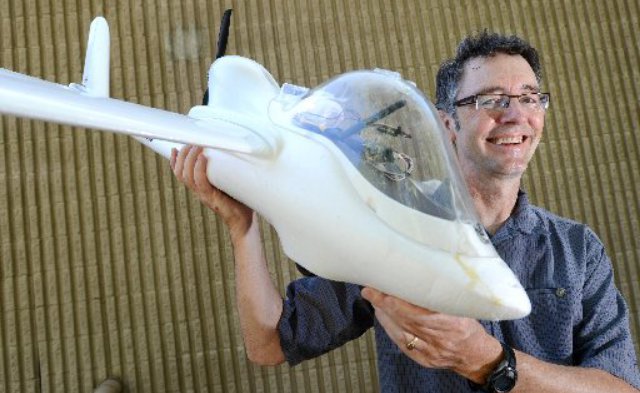Two Boulder businesses are hoping to bring pioneering UAS technology to the age-old business of farming – if only federal regulators will let them out of the barn.
InventWorks and Boulder Labs have developed a UAS they believe could revolutionize the multibillion-dollar business of agriculture, by offering farmers precise locations of weeds that require suppression far more efficiently than could be achieved by any other means.
Jim Sears, head of new product development at Boulder Labs, said, “The fact that we’re in an agricultural application area takes away a lot of the concerns about privacy, which is what a lot of people have. This is not going to threaten people’s sense of privacy, and doing a precision strike on weeds sounds like a good thing.”
It’s not yet known what the two companies’ business model will look like once they can hang out a shingle and charge farmers for their service. Nor have they decided under what business name it will operate.
 Tom McKinnon, Managing Director of InventWorks – Photo: Rachel Woolf
Tom McKinnon, Managing Director of InventWorks – Photo: Rachel Woolf
They are developing a 4-pound, 6-foot-wingspan UAS equipped with multispectral cameras that can capture high-resolution, geo-tagged photographs every few seconds. Those images are then transferred to a ground-based computer where they are merged to create a continuous image of a large farming operation.
The data is processed into image recognition computer algorithms that can recognize features as precise as individual weeds and tie them to GPS coordinates.
By allowing farmers with large acreage to know precisely where the weeds are, they believe farmers can save up to 80 percent per acre on herbicide-based weed suppression.
They have tested their product primarily with a farmer whose dryland operation in northern Montana is nearly the size of Manhattan Island.
“He simply doesn’t have the ability to drive around and look,” McKinnon said. “By the time he got done, the weeds would be taking over his crop.”
The greatest hurdle to InventWorks and Boulder Labs launching their venture is the Federal Aviation Administration, which is under a congressional mandate to incorporate drones into the national airspace by Sept. 30, 2015.
There is a long list of business interests eager to see the FAA finalize a regulatory structure.
“Absolutely, agricultural applications are at the top of the list of activities for applications that could immediately benefit from a change in the regulatory process – in part because it’s such an obvious application,” said Brian Argrow, cofounder of the Research and Engineering Center for Unmanned Vehicles at the University of Colorado.
“You have large expanses of land in which you are trying to make relatively small, precision measurements, typically through some sort of photography or something. It’s much more efficient to do that from a relatively low altitude with a small, low-flying aircraft.”
Under current law, there are two ways to get FAA approval to operate an unmanned aircraft system, or UAS, as the government calls them. One is to obtain an experimental airworthiness certificate. The second is to secure a “certificate of waiver or authorization,” which are typically awarded to public entities such as law enforcement (the Mesa County Sheriff’s Department has one), CU and other universities, or to governmental operations such as firefighting or border patrol.
InventWorks and Boulder Labs have been testing their UAS technology under a third umbrella – a “grey area,” as McKinnon puts it – flying, essentially, as hobbyists, which is permitted if the aircraft remains below 400 feet and steers clear of airports and crowds on the ground.
“Us and thousands of others are flying under the recreational exemption,” McKinnon said. “Since we’re not being paid, we’re kind of like hobbyists. The FAA has only told people to stop in a really small number of cases, and that’s where people were egregiously flying over crowds.”
In this time of waiting for new federal regulations to be finalized, McKinnon and Sears continue to fine-tune their product and develop a suite of potential clients, inside and outside Colorado.
“If it was legal today, we would not be ready, so we do need some development time,” McKinnon said. “But we won’t need two years of development time. We would be easily ready by the 2014 spraying and growing season.”
The reality is that the federal guidelines may not be completed until just after the 2015 season.
“We’re going into this expecting to have to wait out two (more) growing seasons without making any money,” said McKinnon, admitting that having to do so would be “not great.”
Argrow, the UAS expert at CU, said McKinnon and Sears have plenty of company across the country, with countless entrepreneurs increasingly anxious to put UAS to greater commercial use.
Source: Daily Camera
